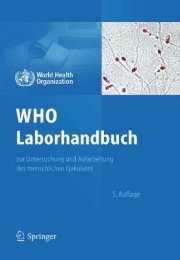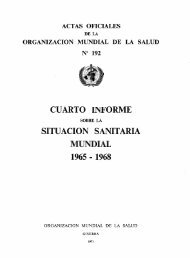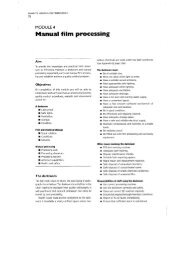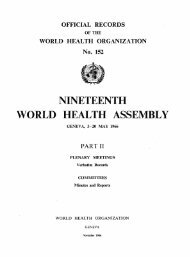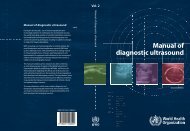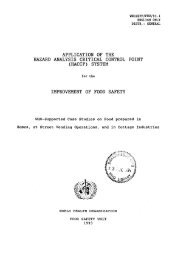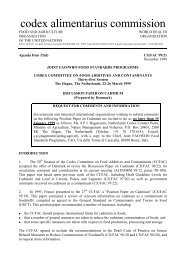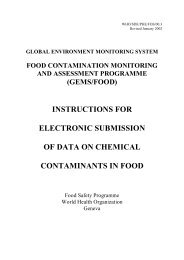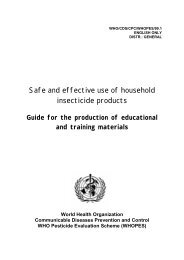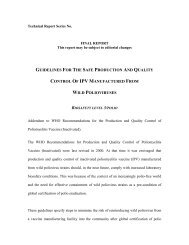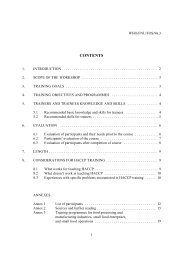WHO Drug Information Vol. 20, No. 4, 2006 - World Health ...
WHO Drug Information Vol. 20, No. 4, 2006 - World Health ...
WHO Drug Information Vol. 20, No. 4, 2006 - World Health ...
Create successful ePaper yourself
Turn your PDF publications into a flip-book with our unique Google optimized e-Paper software.
Proposed INN: List 96 <strong>WHO</strong> <strong>Drug</strong> <strong>Information</strong>, <strong>Vol</strong>. <strong>20</strong>, <strong>No</strong>. 4, <strong>20</strong>06<br />
304<br />
ANNEX 2<br />
GENERAL PRINCIPLES FOR GUIDANCE IN DEVISING INTERNATIONAL<br />
NONPROPRIETARY NAMES FOR PHARMACEUTICAL SUBSTANCES 1<br />
1. International <strong>No</strong>nproprietary Names (INN) should be distinctive in sound and spelling. They should not be inconveniently<br />
long and should not be liable to confusion with names in common use.<br />
2. The INN for a substance belonging to a group of pharmacologically related substances should, where appropriate, show<br />
this relationship. Names that are likely to convey to a patient an anatomical, physiological, pathological or therapeutic<br />
suggestion should be avoided.<br />
These primary principles are to be implemented by using the following secondary principles:<br />
3. In devising the INN of the first substance in a new pharmacological group, consideration should be given to the possibility<br />
of devising suitable INN for related substances, belonging to the new group.<br />
4. In devising INN for acids, one-word names are preferred; their salts should be named without modifying the acid name,<br />
e.g. “oxacillin” and “oxacillin sodium”, “ibufenac” and “ibufenac sodium”.<br />
5. INN for substances which are used as salts should in general apply to the active base or the active acid. Names for<br />
different salts or esters of the same active substance should differ only in respect of the name of the inactive acid or the<br />
inactive base.<br />
For quaternary ammonium substances, the cation and anion should be named appropriately as separate components of a<br />
quaternary substance and not in the amine-salt style.<br />
6. The use of an isolated letter or number should be avoided; hyphenated construction is also undesirable.<br />
7. To facilitate the translation and pronunciation of INN, “f” should be used instead of “ph”, “t” instead of “th”, “e” instead of<br />
“ae” or “oe”, and “i” instead of “y”; the use of the letters “h” and “k” should be avoided.<br />
8. Provided that the names suggested are in accordance with these principles, names proposed by the person discovering<br />
or first developing and marketing a pharmaceutical preparation, or names already officially in use in any country, should<br />
receive preferential consideration.<br />
9. Group relationship in INN (see General principle 2) should if possible be shown by using a common stem. The following<br />
list contains examples of stems for groups of substances, particularly for new groups. There are many other stems in active<br />
use. 2 Where a stem is shown without any hyphens it may be used anywhere in the name.<br />
Latin English<br />
-acum -ac anti-inflammatory agents, ibufenac derivatives<br />
-adolum -adol } analgesics<br />
-adol- -adol-}<br />
-astum -ast anti-asthmatic, anti-allergic substances not acting primarily as<br />
antihistaminics<br />
-astinum -astine antihistaminics<br />
-azepamum -azepam diazepam derivatives<br />
bol bol steroids, anabolic<br />
-cain- -cain- class I antiarrhythmics, procainamide and lidocaine derivatives<br />
-cainum -caine local anaesthetics<br />
1<br />
In its Twentieth report (<strong>WHO</strong> Technical Report Series, <strong>No</strong>. 581, 1975), the <strong>WHO</strong> Expert committee on <strong>No</strong>npropriety Names for Pharmaceutical Substances<br />
reviewed the general principles for devising, and the procedures for selecting, INN in the light of developments in pharmaceutical compounds in recent years. The<br />
most significant change has been the extension to the naming of synthetic chemical substances of the practice previously used for substances originating in or<br />
derived from natural products. This practice involves the use of a characteristic “stem” indicative of a common property of the members of a group. The reason for,<br />
and the implications of, the change are fully discussed.<br />
The guiding principles were updated during the 13 th consultation on nonproprietary names for pharmaceutical substances (Geneva, 27-29 April 1983) (PHARM<br />
S/NOM 928 13 May 1983, revised 18 August 1983).<br />
2<br />
A more extensive listing of stems is contained in the working document <strong>WHO</strong>/PSM/QSM/<strong>20</strong>06.3 which is regularly updated and can be requested from the INN<br />
Programme, <strong>WHO</strong>, Geneva.



